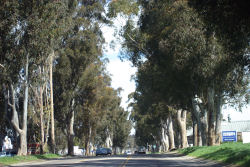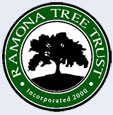As featured in the "Ramona Sentinel"
Link: http://www.ramonasentinel.com/article/News/News/2009_Colonnades_centennial_year/19807
By Diane Conklin
When I first arrived in Ramona in 1999, in transit from overseas and looking for a new home to put down roots, I drove down Main Street into town and was amazed by what I saw: hundreds of magnificent, mature and beautiful trees equal to the mighty trees of Paris, New York or Washington, D.C., lining the street like silent and shady sentinels. It seemed an impossible thing at the time, but its very unlikelihood made me wonder what had happened here to achieve such a memorable result.
| Little did I know then what I know now—that 100 years ago, in 1909, Ramonans planted approximately 2,000 eucalyptus trees bordering the stagecoach road into town from Mussey Grade Road to Eighth Street, and then planted several more times to produce what is known as Ramona’s Historic Colonnade. I was looking at the living legacy of the some hundreds of historical trees that today make up a gift bequeathed to us all a long time ago. |  |
From that moment to this I remain impressed at the generosity and foresight of our community’s forbears, whose desire for beauty and civic pride still define and enhance our town today.
Ramona’s Historic Colonnade of trees did not always grace the entryway into our town and the far reaches of San Diego County’s backcountry. As Ida Bargar recalled in 1974, at the age of 96, Ramona looked very different to her Missouri family at the end of the 19th century. She tells us: “Picture Ramona without Main Street, any eucalyptus trees as an entryway into our town, no vegetation of any kind except brush, and you will see the valley that welcomed a Missouri family, which was to become an important part of the Nuevo Ramona history, when the (Bargar) family arrived here in 1891.”
Pioneer life was harsh, and pioneers were not only strong but had visions of a better life. This desire for something better is what drove them to move from the place they knew to a place they did not. It was always a gamble, but often it paid off.
Ramona’s history, extending back to the time when the Santa Maria Valley was along the traveled route from San Diego to the mountains and onto the Santa Ysabel Mission established in 1818, spans many different phases of development. The timeline includes the purchase of the Rancho Santa Maria o Valle de Pamo—17,708 acres including today’s community of Ramona, by Jose Joaquin Ortega and his son-in-law, English Captain Edward Stokes, in 1843. Used primarily as grazing land until developed in the 1870s by French immigrant Bernardo Etcheverry to include fruit orchards, grain fields, as well as sheep grazing, the valley was forever changed by the steady flow of American settlers into California from the 1880s onward.
Agriculture continued to be the primary land use in the Santa Maria Valley throughout the reminder of the 19th century and into the early 20th. The farming community’s pride centered on Main Street, where important commercial businesses, such as the Verlaque General Store (now the Guy B. Woodward Museum), the famed Kenilworth Inn, which sadly no longer exists, and the all-important Ramona Town Hall, built by Augustus Barnett, were established.
By the beginning of the 20th century, the rural agricultural landscape of the Ramona Valley began to be characterized by windrows and groves of eucalyptus trees, as plantings by California cities and towns for shade, beauty and to enhance ranch and residential landscapes became common.
Encouraged by the State of California through legislation in 1913 and 1931, tree planting along state highways included Route 91 from Fresno to Bakersfield, Highway 99 from Marysville to Modesto and Highway 17 in the Bay area. Sunset Magazine identified three sections of Highways 101 and 99 where eucalyptus trees lined a day’s drive of roadway. Throughout the state, stands of eucalyptus trees that lined the entrances to towns became landmarks of home.
Unfortunately, many of the trees planted by settlers for posterity have not survived. However, the trees that line Main Street from the western end of the valley through the eastern end of town have not only survived, they are a well-known Ramona feature.
As a result of the collective work of generations of Ramonans, today’s colonnade stretches almost two miles from Wynola to Ninth Street. On this Centennial of the Ramona Historic Colonnade, hundreds of trees more than 70 feet tall grace the community. Of the 302 trees along Main Street, 226 are historic eucalyptus trees (planted between 1909 and 1931); these are interspersed with 76 smaller trees, planted by the Ramona community at large and since 2002 by the Ramona Tree Trust, which has planted 60 trees on Main Street in cooperation with the California Department of Transportation.
The idea to plant the trees began in 1908, when the Ramona Improvement Club, led by A. Foster and W.E. Woodward, secured an agreement with the county supervisors that, if the club acquired and planted the trees, the county would fund their care and protection until they could thrive on their own.
Trees were donated by Colonel D.C. Collier to the club and in 1909 the San Diego Union newspaper commended Ramona residents for “successfully planting trees for three miles along either side of the main highway toward the top of Mussey Grade.”
Due to the harshness of the soil, the hard work to provide water and the dry Ramona summers, many young trees did not survive. So another plating occurred in 1910, described by Mrs. Carlin Dougherty when, as a little girl of 8, she and several other young children pulled small wagons filled with young trees and helped to plant over 500 trees on Ramona’s Main Street. Amy Strong, of the Castle on Mt. Woodson, a famous seamstress and early Ramona benefactor reportedly obtained trees from Kate Sessions, noted early botanist in San Diego, who planned and planted much of the early Balboa Park area. Some of these trees graced the entryway into the old Kenilworth Inn.
By the time of the third planting in the 1930s, the Ramona community had sewn the seeds of a lasting tree colonnade reflecting their pride in themselves and their thriving rural towns. This very same colonnade has survived 100 years and is recognized in the Ramona Community Plan in our own times as a town feature to be protected to preserve our rural community character.
Today, the 100-year-old Ramona Historic Colonnade is one of the last remaining street colonnades of its type in Southern California. Carrying on the tradition of planting, in the early 21st century the colonnade has benefited from several plantings by the all-volunteer Ramona Tree Trust.
Made up of a group of dedicated individuals who have been working for almost 10 years to enhance Ramona through tree plantings, including plantings on Main Street, the Trust was formally incorporated in 2000. Where the trees are not irrigated, they have been hand watered for years by Kevin McNulty, a member of the Trust Board of Directors.
The goal of the Trust is to add a total of 100 trees to the colonnade so that the two miles of trees will continue to remind us of what can be done when people care about their community both for now and beyond their own lifetimes.
Ramona’s magnificent trees are yours to enjoy. Next time you drive into town from “down the hill,” take a breath and enjoy what you have been given—a living legacy for you and yours, 100 years of green and still going strong.
Diane Conklin is president of the Ramona Tree Trust, a 501(c)(3) charitable organization. Board members are: Julie Iavelli, treasurer; Carolyn Dorroh, secretary; Roy Hashberger, tree steward; and Kevin McNulty, grants coordinator. In addition to planting in Ramona’s Historic Colonnade, the Trust grants funds for planting of trees in public spaces. More information can be accessed at www.ramonatreetrust.org.






